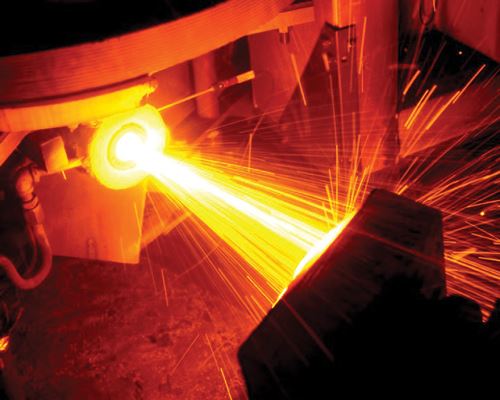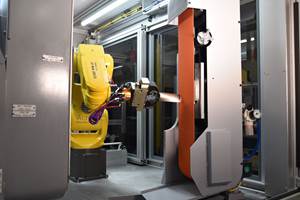Molten Spray Moldmaking
Rapid solidification creates mold and die tooling that is harder than heat treated components, within build times that are faster than machining.
[Editor's note: RSP Tooling, the company mentioned in the article below, no longer has a license agreement related to the Rapid Solidification Process (RSP). Premier Technology (www.ptius.com) now has a license agreement with Idaho National Laboratory related to RSP. A representative of Premier Technology told me the company's aim is to develop and sell machinery for producing large tooling and dies with this technology, but the timeframe for achieving this is unknown. Therefore, the article below is presented as information on an additive manufacturing approach that is likely to be available in the future. —PZ]
Because additive manufacturing processes are not affected by geometric detail, they ought to be ideal for making molds and dies. The complex features of these parts that slow down machining do not have to affect the speed of a process that builds parts layer by layer. However, size is a problem. Equipment for building additive metal parts is typically much more expensive than comparably sized CNC machine tools. Cost, among other factors, prevents additive equipment from scaling up to the size of a large mold or die.
Related Content
Copper, New Metal Printing Processes, Upgrades Based on Software and More from Formnext 2023: AM Radio #46
Formnext 2023 showed that additive manufacturing may be maturing, but it is certainly not stagnant. In this episode, we dive into observations around technology enhancements, new processes and materials, robots, sustainability and more trends from the show.
Read MoreVulcanForms Is Forging a New Model for Large-Scale Production (and It's More Than 3D Printing)
The MIT spinout leverages proprietary high-power laser powder bed fusion alongside machining in the context of digitized, cost-effective and “maniacally focused” production.
Read More3D Printed Cutting Tool for Large Transmission Part: The Cool Parts Show Bonus
A boring tool that was once 30 kg challenged the performance of the machining center using it. The replacement tool is 11.5 kg, and more efficient as well, thanks to generative design.
Read MoreAircraft Engine MRO: How Additive Manufacturing Plus Robotic Finishing Will Expand Capacity for Blade Repair
AM offers the chance to bring fast, automated processing to individualized, part-by-part restoration of turbomachinery. A cell developed by Acme Manufacturing and Optomec is able to automatically repair 85,000 unique aircraft engine blades per year.
Read MoreRead Next
Video: Intelligent Layering Metal 3D Printing at 3DEO
Contract manufacturer 3DEO delivers metal parts using Intelligent Layering, a binder jetting-like 3D printing process the company developed and operates internally. Here’s how it works.
Read MoreTo Improve Performance of Compression Molded Composites, Add 3D Printed Preforms
9T Labs' Additive Fusion Technology enables the manufacture of composite structures with as much or as little reinforcement as is necessary, using 3D printed continuous fiber preforms to add strength just where needed.
Read More3D Printing Brings Sustainability, Accessibility to Glass Manufacturing
Australian startup Maple Glass Printing has developed a process for extruding glass into artwork, lab implements and architectural elements. Along the way, the company has also found more efficient ways of recycling this material.
Read More
.jpg;width=70;height=70;mode=crop)








.png;maxWidth=300;quality=90)













